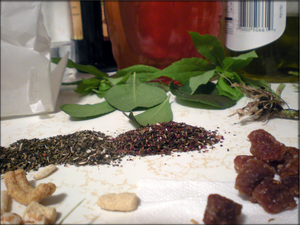Alternative medicine should never be used in place of professional medical practices. Consult the guidance of your physician or health care provider before trying any herbal remedy.
These are six of the most commonly used preparations in traditional herbal medicine. They are based on a tried and true set of standards that have changed very little over the past 200 years. The measurements used here are very basic and can be adjusted to accommodate both the amount of available plant material on hand, and the desired potency of the medicine itself. Learn them well, and with a little practice, you’ll be making your own professional herbal medications in no time.
Infusions
An infusion is made by adding the aerial parts of the plant (leaves, stems and flowers) to hot water and steeping them to extract their active ingredients. This is your common everyday herbal tea. Infusions minimize the loss of the plant’s volatile oils due to their relatively short exposure to heat. To make an infusion, add ½ to 1 ounce of herb to a pint of hot water. Let steep for five to ten minutes, strain through a cheese cloth and drink while it’s still hot.
Decoctions
Harder materials, like roots, barks and seeds generally require boiling to extract their active ingredients. Decoctions allow you to extract the minerals and bitter properties of the plant, rather than the vitamins and volatile oils. To make a decoction, add the same amount of herb that you would in an infusion, but double the amount of water. Bring to a boil, reduce heat and let simmer until the water has been reduced by half. Strain through a cheese cloth and let cool before drinking.
Tinctures
Herbal tinctures are great for internal and external applications. For the later, the alcohol in tinctures absorbs quickly into the skin. This allows the medicine to be carried directly to the affected area. Homeopaths use a diluted form of herbal tincture for their own medicinal preparations. To make a tincture, combine 1 to 4 ounces of herb (depending on the desired potency of the medicine) with 8 to 12 ounces of Vodka. Let the mixture stand for about two weeks, shaking it once or twice daily. Strain the final product and pour it into an airtight bottle. Stored at room temperature, tinctures will last for weeks.
Syrups
Medicinal syrups are especially good for administering herbal medicines to children. To make them, simply add 1 ounce of herb to about 12 ounces of honey (do not feed honey to children under one years of age) or any other store brand syrup. Bring the syrup up to heat slowly and then simmer for about five minutes. Strain through a cheese cloth and let cool to room temperature. Stir in one capsule of vitamin E to help preserve the preparation and then pour it back into its original container. Medicinal syrups should always be stored in the refrigerator when not in use.
Ointments
Herbal ointments come in many varieties and are very easy to make. A simple salve can be made by combining 1 ounce of powdered herb to a jar of petroleum jelly. To do this, bring the petroleum jelly up to heat slowly and then stir in the herb a little at a time. Keep stirring the mixture while it simmers for about five minutes, remove from heat and then strain it through a cheese cloth. Let it cool slightly and then pour it back into its original container before it solidifies.
Medicinal oils and massage oils can be made the same way. Just use a good Olive or sesame seed oil instead of the petroleum jelly. Add 1 drop of tincture of benzoin per ounce of oil to the finished product to help preserve it for storage.
Poultices
Traditional poultices were used to treat inflamed joints, muscles and ligaments, and to help disperse bruising. To make a poultice, combine powdered herbs in a bowl and mix it into a thick paste using a little hot water. Rub a little oil on the skin and then apply the paste directly to the affected area. Cover with a cloth or bandage and apply a warming pad to keep heat on the poultice.



